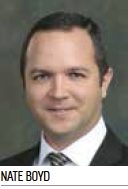While some airport operators talk about reducing energy consumption, others take action to make it happen. Orlando International Airport (MCO) recently committed to the goal of using 10% less energy in its facilities by 2018, a move that will significantly reduce operating costs and may boost the airport’s reputation from “eco-friendly” to “eco-friendlier.”
MCO is following a multi-phase strategy developed by Hanson Professional Services to reduce its largest utility bill: $14+ million per year for electricity. By implementing the first phase of the recommendations, the airport already has reduced energy expenses by roughly 6%-about $1.2 million-since 2012 and decreased greenhouse-gas production by 9%, reports Jeff Daniels, assistant director of maintenance operations at MCO.
 FACTS&FIGURES FACTS&FIGURESProject: Energy Reduction Plan Location: Orlando Int’l Airport 2015 Passenger Volume: Almost 40 million Project Cost: About $125,000 Funding: Airport Consultant: Hanson Professional Services Primary Goal: Consume 10% less energy by 2018 Main Projects: Upgrading system controls; replacing existing light bulbs with longer-lasting, more energy-efficient LEDs Key Benefits: Lower operating & maintenance expenses; less greenhouse gas emissions; more eco-friendly operations |
An array of measures, such as replacing aging equipment and installing better controls for air conditioning and lighting systems, produced most of the cost savings. In addition, the airport replaced thousands of fluorescent and incandescent light bulbs with more energy-efficient and longer-lasting LED bulbs, Daniels says, citing another example.
Notably, the airport has managed to reduce its energy consumption despite increasing passenger traffic. “We experience approximately an eight percent passenger increase every year and are adding square footage all the time,” Daniels explains. “So our challenge is to control the growth of energy usage even as we’re growing in terms of passenger levels and facilities.
“There are a lot of human candles running through here every year-about 39.5 million passengers last year alone,” he continues. “That means there are a lot of people using moving sidewalks, elevators, escalators, restrooms and trains. Typically, as you increase usage of those things, the associated energy load increases, too. We’ve not only been able to control energy use, but even reduce it during a high-growth period.”
MCO is using the energy utilization index (EUI) to measure progress toward its 10% reduction goal. EUI expresses energy used per square foot in facilities, similar to the way miles-per-gallon expresses fuel use by vehicles. Using EUI allows officials to compare the energy consumed by different types of systems-steam vs. water-cooled systems, for example-on an apples-to-apples basis, says Daniels.
“EUI is the only realistic way to accurately measure comparisons,” he asserts. “Our total EUI is down by about 4.5 percent since 2012. Typically, I’d guess it would have increased more than 10 percent during that time period.”
Developing a Plan
Social consciousness also provided significant impetus for MCO’s energy initiatives. “We’re a big part of the community here,” Daniels explains. “So we need to be sure we’re doing our share in terms of energy conservation. Too often airports are seen as big energy wasters and producers of excessive greenhouse gases.”
Last April, airport officials consequently awarded Hanson a $125,000 contract to develop a master plan for energy conservation.
“On my end of the business, our responsibility always is to find ways to reduce energy usage,” Daniels comments. “We have a responsibility to our community and to the world. Many times, that results in savings that can be passed along to our customers. That’s not the primary consideration here, but it can work out that way…anything that helps airlines pay lower fees is great.”
 To develop a comprehensive plan, Hanson is reviewing the airport’s operations in phases. During phase one, the engineering and allied services firm performed energy audits in MCO’s ancillary airport buildings. Using those results, personnel ranked various energy-conservation measures in a logical sequence to deliver the most cost-effective results, explains Nate Boyd, a mechanical engineer and energy specialist at Hanson.
To develop a comprehensive plan, Hanson is reviewing the airport’s operations in phases. During phase one, the engineering and allied services firm performed energy audits in MCO’s ancillary airport buildings. Using those results, personnel ranked various energy-conservation measures in a logical sequence to deliver the most cost-effective results, explains Nate Boyd, a mechanical engineer and energy specialist at Hanson.
“Our overall goal is to identify current energy use in each building and asset at the airport, identify realistic savings targets and determine a methodology, through energy-conservation measures, to achieve those goals,” says Boyd.
For example, the payback on upgrading building automation systems might come sooner than the payback for replacing heating, venting and air conditioning (HVAC) equipment. But if the HVAC equipment is old, it may make more sense to replace it first and then install a new control system.
 “We call it a rack-and-stack method, where we analyze a number of different things to rank those projects by using three primary criteria: cost, anticipated savings and return on investment,” Boyd says. “Sometimes indoor air quality also is a ranking factor.”
“We call it a rack-and-stack method, where we analyze a number of different things to rank those projects by using three primary criteria: cost, anticipated savings and return on investment,” Boyd says. “Sometimes indoor air quality also is a ranking factor.”
Small Changes, Big Results
After the phase one review, Hanson proposed 38 energy conservation measures; and the airport elected to implement 19 of them. The result: an estimated savings of $70,000 a year, with a payback period of just less than five years, Boyd reports. Most of the changes involved optimizing the operation of existing HVAC systems in ancillary buildings and swapping out existing light bulbs with LED light bulbs.
“For example, we made programming changes to the systems that control things like the speed output of fans or the damper positions within HVAC equipment,” Boyd says. “There’s a lot of energy to be saved by reducing the speed of fans or pumps if water or air flow isn’t needed…a lot of times the original programming takes a very conservative approach that sends more air and water into systems than needed-sort of a just-to-be-sure philosophy.”
It may seem like a stretch that a small change in fan speeds could have a significant impact. But if the airflow of just one fan is cut in half, it uses just 1/8 of the energy it did before, points out Boyd. “And we’re easily talking hundreds of fans and pumps in an airport of this size, so little changes throughout the system add up to significant savings,” he emphasizes. “If you take these hundreds of fans and pumps all over the airport and dynamically control their air flow, you’re talking about potentially saving hundreds of thousands of dollars.”
Better programming capability saves money because MCO personnel can now monitor conditions throughout the airport more accurately and make adjustments faster. For example, the new controls send an alarm if an air-handling unit goes out of calibration. This allows employees to adjust it immediately, as opposed to waiting (possibly for hours) for someone to complain about a room being too hot or too cold.
The airport also installed occupancy sensors that automatically reduce heat or air conditioning and turn off lights when rooms are unoccupied. “If there’s plenty of sunlight in a room, for example, it will automatically turn off any lights,” explains Daniels. “And if a lot of people leave, say, a baggage claim area, the system senses that and turns off lights and adjusts the air conditioning accordingly.”
Next Step: Airside Terminals
The second phase of Hanson’s plan included energy audits in three of the airport’s four airside terminals. (The fourth terminal was not included because it’s undergoing renovations.) The company also worked with the Orlando Utility Commission to compile three-, five- and 10-year forecasts of items such as utility tariffs, rebates and incentive programs, pending legislation and infrastructure improvements. The team also gained insight about potential plans and timelines for upgrading transmission lines or substations and other projects that would affect the airport. In short, Hanson investigated anything that might affect the airport’s future utility costs, Boyd says.
MCO received a review of Hanson’s second phase of audits last fall and is implementing the bulk of its recommendations this year. Projects largely focus on upgrading controls for air conditioning systems in the three terminals. In effect, the new controls allow the complex system of pumps and valves that distribute chilled water to the terminals to operate more efficiently, Boyd explains.
“Now, if the valves close off, then a set point in the chilled water system can slowly ratchet down and slow the pumps down, too,” he elaborates. “Those valves are set to deliver a designed flow rate (of chilled water) to the farthest coil in the loop to ensure that, in any circumstance, the necessary amount of water required by the farthest coil is always available.
“Now, that set point responds to the position feedback from the valves, where before it remained at a set differential pressure set point,” he adds. “It now effectively becomes a self-learning system that delivers what’s needed, as opposed to possibly over-compensating for a worst-case scenario.”
 Although it’s too early to definitively quantify results from changes made during phase two, Boyd expects cost savings to range from tens of thousands of dollars to more than $100,000 per year.
Although it’s too early to definitively quantify results from changes made during phase two, Boyd expects cost savings to range from tens of thousands of dollars to more than $100,000 per year.
Beyond acting on Hanson’s recommendations, the airport has also spent about $4 million over the last five years to replace four aging centrifugal chillers with high-efficiency units, plus three older cooling towers. Three remaining cooling towers also are scheduled for replacement.
“They were replaced more because of their age than for energy savings,” notes Daniels. “We’re also building a new centrifugal chiller plant to accommodate an expansion of one of our airside terminals. It features four magnetic-bearing (vs. oil-bearing) chillers and will be one of most efficient chiller plants in the Southeast.”
 Looking Ahead
Looking Ahead
Currently, the airport is considering a third phase, in which Hanson would audit facilities not addressed in previous efforts. Boyd says that the idea is to continuously update the energy roadmap every one to three years, depending on how long it takes to execute measures the airport decides to implement.
For other airports interested in reducing energy usage, Boyd suggests starting with “low-hanging fruit.” Upgrading controls for air conditioning and heating systems provides immediate savings for the least amount of investment, he notes. “The development of optimized programming is continuously evolving,” he observes. “The sophistication of programming keeps getting better and better, which allows us to fine-tune systems better.”
Daniels identifies hiring a consultant to perform an energy audit as a critical first step. In addition to identifying high-priority measures, an audit provides building managers with an action plan and helps airport officials develop a capital improvement plan for funding purposes, he explains.
“You’ve got to have a plan,” Daniel stresses. “Like the old saying goes: People don’t plan to fail, they fail to plan.”



